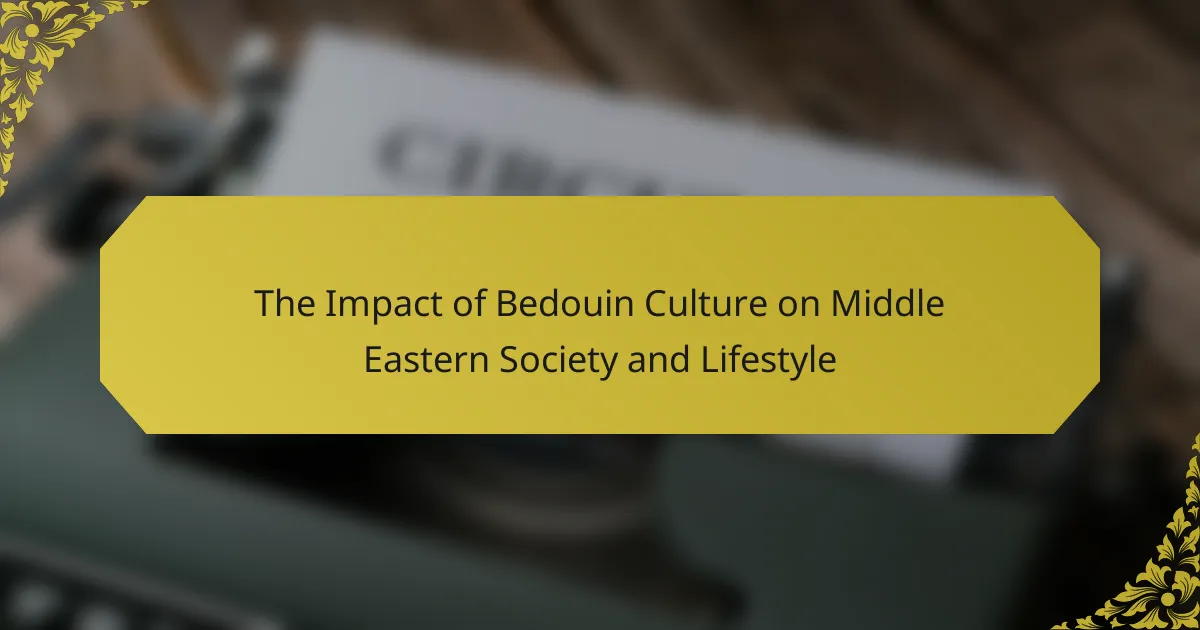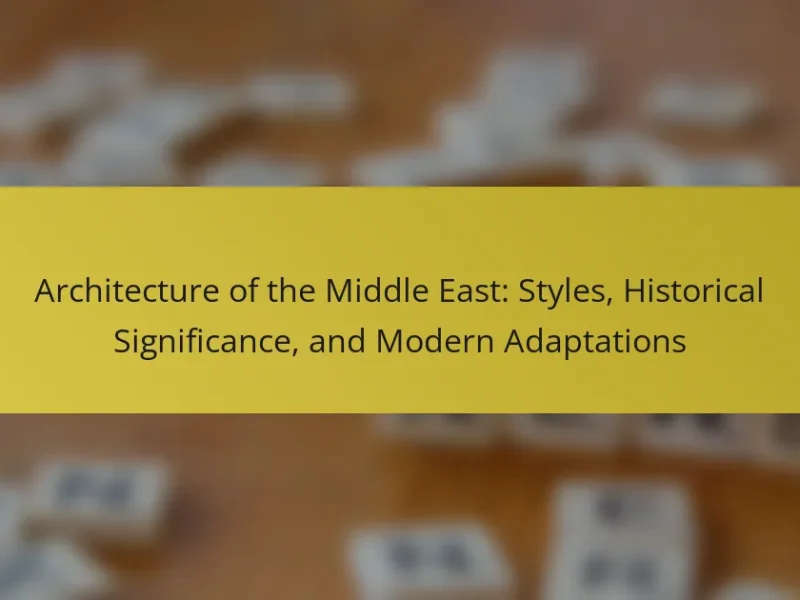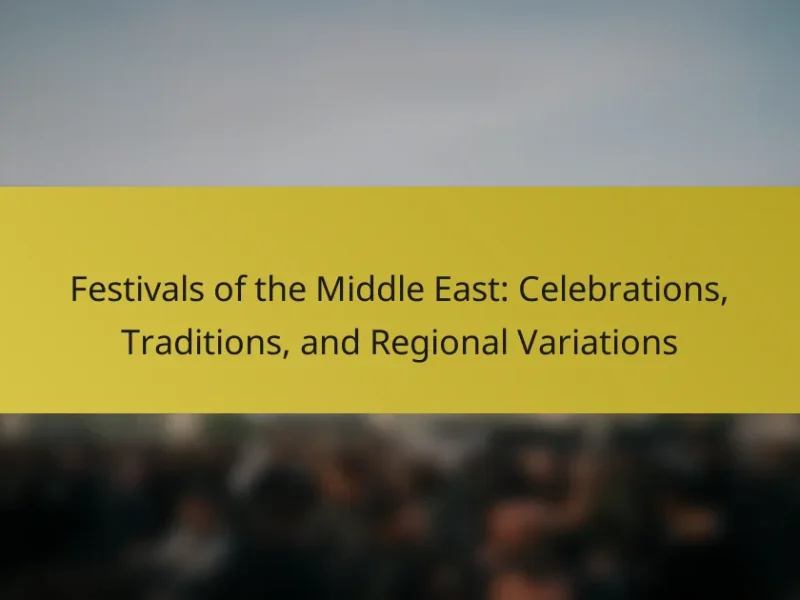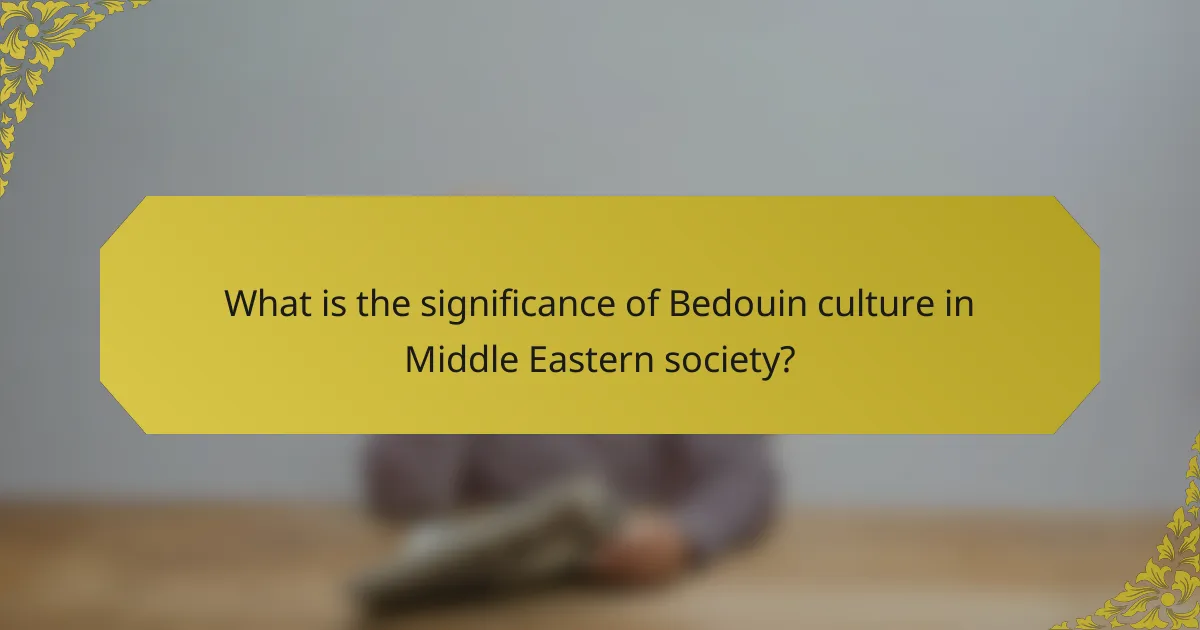
What is the significance of Bedouin culture in Middle Eastern society?
Bedouin culture holds significant importance in Middle Eastern society. It represents a rich heritage of nomadic traditions and customs. Bedouins are known for their hospitality, which fosters community bonds. Their social structures emphasize kinship and loyalty, influencing regional social dynamics. Bedouin poetry and storytelling preserve historical narratives and cultural identity. Traditional crafts, such as weaving and pottery, showcase artistic skills and cultural expressions. The Bedouin way of life has contributed to the region’s cultural diversity. Their practices have also influenced contemporary art, music, and literature in the Middle East.
How has Bedouin culture influenced social structures in the region?
Bedouin culture has significantly influenced social structures in the Middle East. It emphasizes tribal affiliation and kinship, shaping community dynamics. The Bedouin code of honor fosters loyalty and mutual support among members. This has led to strong networks of cooperation within tribes. Additionally, the nomadic lifestyle promotes adaptability and resource sharing. Such traits have been integrated into broader social frameworks in the region. Historically, Bedouin tribes played crucial roles in trade and diplomacy, affecting political alliances. Their customs and traditions continue to impact social norms today.
What traditional practices are central to Bedouin social life?
Central traditional practices in Bedouin social life include hospitality, oral storytelling, and communal gatherings. Hospitality is a cornerstone of Bedouin culture, emphasizing the importance of welcoming guests. Bedouins often serve coffee and meals to visitors as a sign of respect. Oral storytelling preserves history and cultural values, often shared during evening gatherings. These stories reinforce social bonds and transmit knowledge across generations. Communal gatherings, such as weddings and festivals, strengthen community ties. Such events are marked by traditional music, dance, and shared meals, fostering unity among families and tribes. These practices reflect the Bedouins’ deep-rooted values of community, respect, and tradition.
How do familial ties shape Bedouin communities?
Familial ties are fundamental in shaping Bedouin communities. These ties create a strong sense of identity and belonging. Kinship dictates social structure and governance within the community. Families often operate collectively, sharing resources and responsibilities. This cooperation enhances survival in harsh desert environments. Loyalty to family influences decision-making and conflict resolution. Elders hold authority, guiding younger generations based on tradition. The importance of these ties is evident in communal gatherings and rituals. Overall, familial connections reinforce cultural continuity among Bedouins.
What role does Bedouin culture play in regional identity?
Bedouin culture significantly influences regional identity in the Middle East. This culture embodies values such as hospitality, honor, and resilience. These values shape social interactions and community structures among various groups. The Bedouins’ nomadic lifestyle connects them deeply to the desert landscape. Their traditional practices, including music, dance, and storytelling, enrich local heritage. Bedouin tribes often serve as custodians of historical narratives and oral traditions. This cultural preservation fosters a sense of belonging and continuity in the region. Furthermore, Bedouin customs influence contemporary art and literature, reinforcing their impact on regional identity.
How do Bedouin customs contribute to a sense of belonging?
Bedouin customs foster a strong sense of belonging through shared traditions and communal practices. These customs include hospitality, storytelling, and communal gatherings. Hospitality is a core value, where offering food and shelter to guests strengthens social bonds. Storytelling serves as a means of passing down history and values, uniting members through shared narratives. Communal gatherings, such as weddings and festivals, reinforce social ties and collective identity. Additionally, shared practices like traditional dress and music create a visual and auditory sense of belonging. These customs create a cohesive community, enhancing individual identity within the larger Bedouin culture.
What are the unique attributes of Bedouin heritage that impact identity?
Unique attributes of Bedouin heritage impacting identity include a strong sense of community, oral traditions, and nomadic lifestyle. The Bedouins prioritize family and tribal affiliations, shaping social structures. Oral storytelling preserves history and cultural values, fostering a collective identity. Their nomadic lifestyle promotes adaptability and resilience, influencing survival strategies. Traditional crafts, such as weaving and pottery, reflect cultural identity and artistic expression. Hospitality is a core value, reinforcing social bonds and community cohesion. The connection to the desert landscape shapes their worldview and identity. These attributes collectively define Bedouin identity within the broader Middle Eastern context.
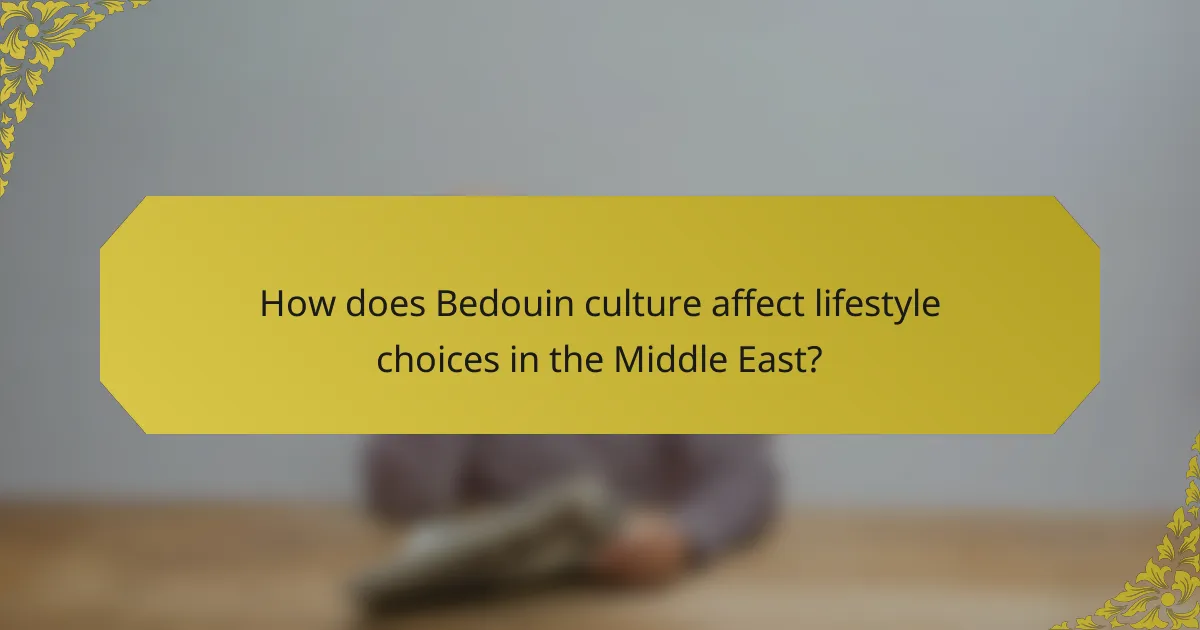
How does Bedouin culture affect lifestyle choices in the Middle East?
Bedouin culture significantly influences lifestyle choices in the Middle East. This nomadic culture emphasizes community, hospitality, and tradition. Bedouins often prioritize family ties and social networks in their decision-making. Their reliance on livestock shapes dietary habits, favoring meat and dairy products. The desert environment dictates clothing choices, with lightweight fabrics suited for hot climates. Cultural practices also impact education, with many valuing informal learning through oral traditions. Additionally, Bedouin customs promote sustainability, leading to resourceful living in arid conditions. The historical significance of Bedouin tribes contributes to regional identity and social structure.
What are the traditional Bedouin practices that influence daily life?
Traditional Bedouin practices significantly influence daily life through their customs, social structures, and survival techniques. One prominent practice is the nomadic lifestyle, which emphasizes mobility and adaptability to desert environments. This lifestyle shapes daily routines, including the timing of meals and social gatherings around seasonal migrations.
Another key practice is hospitality, which is a cornerstone of Bedouin culture. Guests are treated with utmost respect, and this tradition fosters community bonds and social networks. Additionally, traditional crafts such as weaving and pottery are vital for economic sustenance and cultural identity.
The use of specific dietary practices, such as consuming dates and camel milk, reflects the resourcefulness of Bedouins in utilizing available resources. Moreover, oral storytelling and poetry play a crucial role in preserving history and values, influencing the education of younger generations.
These practices collectively form a cultural framework that shapes the social interactions and daily activities of Bedouin communities.
How do food and hospitality reflect Bedouin traditions?
Food and hospitality in Bedouin culture reflect deep-rooted traditions of generosity and communal living. Bedouins traditionally serve coffee and dates to guests as a symbol of welcome. This practice signifies respect and honor for visitors. Meals often consist of lamb, rice, and spices, showcasing the region’s agricultural heritage. The communal sharing of food fosters social bonds among family and friends. Hospitality extends beyond mere sustenance; it is a cultural obligation. Bedouins believe that treating guests well brings blessings. Historical accounts illustrate that this tradition has been vital for survival in harsh desert environments. Overall, food and hospitality are integral to Bedouin identity and cultural continuity.
What impact does nomadic lifestyle have on resource use?
Nomadic lifestyle significantly influences resource use by promoting sustainable practices. Nomads often rely on renewable resources, such as grazing lands and water sources, which they use in a rotational manner. This approach helps prevent over-exploitation of any single area. For instance, Bedouins traditionally move their herds to avoid depleting vegetation in one location. Studies show that this mobility allows for the regeneration of ecosystems. Additionally, nomadic groups often maintain a deep understanding of their environment. This knowledge aids in the efficient use of resources, ensuring their availability for future generations. Overall, the nomadic lifestyle fosters a balance between resource use and ecological sustainability.
In what ways does Bedouin culture intersect with modern lifestyles?
Bedouin culture intersects with modern lifestyles through the integration of traditional practices into contemporary settings. Many Bedouins now blend their nomadic heritage with urban living. This includes maintaining traditional crafts, such as weaving and pottery, while selling goods in modern markets. Bedouin hospitality remains a core value, influencing social gatherings in urban areas. Additionally, traditional music and dance are featured in modern celebrations and events. Bedouins also adopt modern technology, using social media to share their culture globally. Education has become more accessible, leading to a blend of traditional knowledge and modern academic learning. These intersections illustrate the adaptability of Bedouin culture within the framework of modern society.
How are Bedouin traditions adapted in urban settings?
Bedouin traditions are adapted in urban settings through the integration of cultural practices into modern lifestyles. Urban Bedouins often maintain traditional clothing, such as the thobe and keffiyeh, while incorporating contemporary fashion. Social gatherings, like weddings and festivals, reflect Bedouin customs but are often held in urban venues. Traditional music and dance are performed at events, blending with popular urban styles. Food remains a vital aspect, with traditional dishes served alongside modern cuisine. Additionally, storytelling and poetry are preserved in community events, fostering cultural continuity. This adaptation allows for the preservation of identity while embracing urban life.
What challenges do Bedouins face in maintaining their culture amidst modernization?
Bedouins face significant challenges in maintaining their culture amidst modernization. Rapid urbanization threatens traditional nomadic lifestyles. Increased access to education leads younger generations to pursue urban careers. This shift results in a decline of traditional knowledge and practices. Economic pressures push Bedouins to abandon their ancestral lands. Modern technology often replaces traditional methods of living. Additionally, government policies may favor settled lifestyles over nomadic ones. Cultural assimilation into mainstream society further dilutes Bedouin identity. These factors collectively jeopardize the preservation of Bedouin cultural heritage.
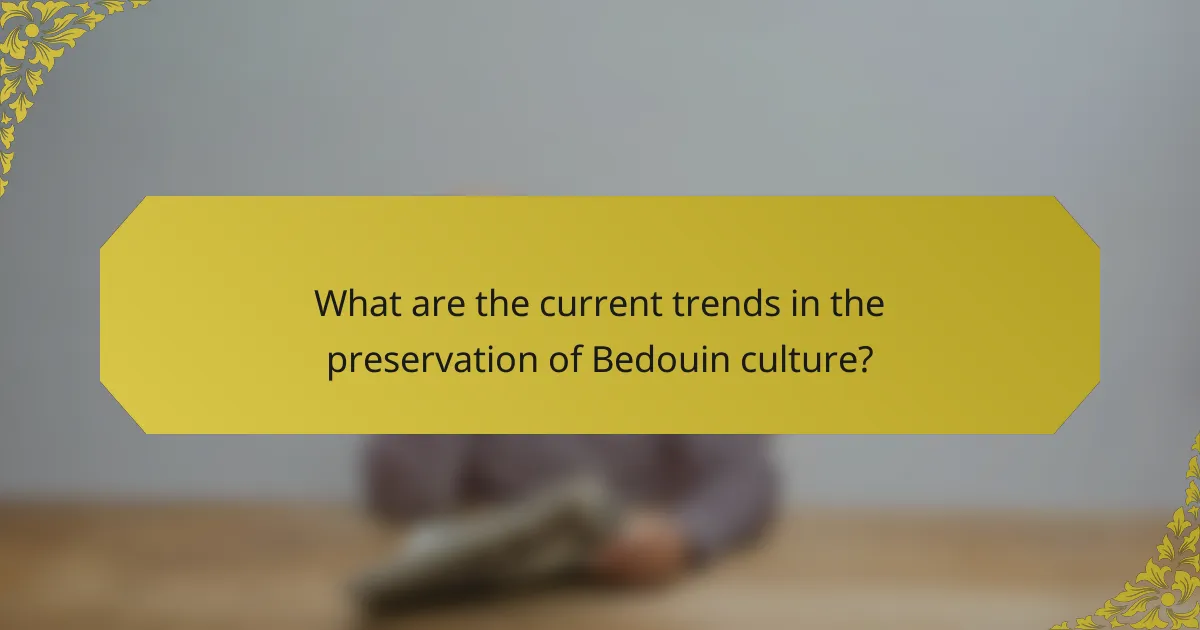
What are the current trends in the preservation of Bedouin culture?
Current trends in the preservation of Bedouin culture include the revival of traditional crafts and storytelling. Many Bedouin communities are focusing on passing down oral histories to younger generations. Cultural festivals are being organized to celebrate Bedouin music, dance, and cuisine. Educational programs are being implemented to teach Bedouin language and traditions in schools. Collaborations with NGOs are increasing to support sustainable tourism that respects Bedouin heritage. Additionally, social media is being used to promote Bedouin culture globally. These efforts aim to maintain cultural identity in the face of modernization.
How are Bedouin cultural practices being revitalized today?
Bedouin cultural practices are being revitalized today through various initiatives. These include educational programs aimed at preserving traditional knowledge. Community festivals celebrate Bedouin heritage and promote cultural exchange. Additionally, art and crafts workshops enable younger generations to learn traditional skills. Social media platforms are used to share Bedouin stories and customs widely. Government and NGO support has increased funding for cultural preservation projects. Academic research also documents and analyzes Bedouin traditions, fostering awareness. Overall, these efforts contribute to a renewed interest in Bedouin culture within and beyond their communities.
What role do educational initiatives play in cultural preservation?
Educational initiatives are crucial for cultural preservation. They foster awareness and understanding of cultural heritage. Programs in schools and communities teach traditional practices and languages. This transmission of knowledge helps maintain cultural identity. For example, Bedouin educational initiatives highlight their unique customs and history. Research shows that such programs increase cultural pride among younger generations. They also encourage community engagement and participation in cultural events. Ultimately, educational initiatives serve as a bridge connecting past traditions with future generations.
How can tourism support the sustainability of Bedouin culture?
Tourism can support the sustainability of Bedouin culture by providing economic benefits and promoting cultural exchange. Economic opportunities arise from tourism-related activities, such as guided tours and cultural events. These activities create jobs for local Bedouins, which helps preserve their traditional lifestyles. Cultural exchange fosters appreciation for Bedouin customs and traditions among visitors. This increased awareness encourages the preservation of their heritage. Studies show that sustainable tourism initiatives can enhance community involvement. For example, programs that engage Bedouins in tourism planning lead to better cultural representation. Overall, tourism acts as a vital resource for maintaining Bedouin culture in a modern context.
What practical steps can individuals take to support Bedouin culture?
Individuals can support Bedouin culture by promoting and purchasing traditional crafts. This includes items such as woven textiles and pottery. Supporting local artisans helps preserve cultural practices.
Another practical step is to participate in cultural events or festivals. These gatherings often showcase Bedouin music, dance, and storytelling. Attending these events fosters appreciation and awareness.
Additionally, individuals can advocate for the rights of Bedouin communities. This can involve raising awareness about their challenges and supporting policies that protect their heritage.
Engaging with Bedouin communities through respectful tourism can also be beneficial. This approach ensures that benefits from tourism are directed to the local culture and economy.
Lastly, educating oneself and others about Bedouin history and traditions is essential. Knowledge can lead to greater respect and understanding of their contributions to society.
How can community engagement foster appreciation for Bedouin traditions?
Community engagement can foster appreciation for Bedouin traditions by actively involving individuals in cultural practices. Participation in traditional events allows people to experience Bedouin heritage firsthand. Workshops on crafts like weaving or pottery provide practical knowledge and skills. Educational programs about Bedouin history deepen understanding of their cultural significance. Collaborative projects can highlight the importance of preserving these traditions. Engaging local youth in cultural activities ensures the transmission of knowledge to future generations. Studies show that hands-on involvement increases respect for diverse cultures. Such engagement creates a sense of community and shared identity, reinforcing appreciation for Bedouin traditions.
What resources are available for learning about Bedouin culture?
Books on Bedouin culture are available for learning. “The Bedouins: Culture and Society” by A. A. Al-Nahedh provides insights into their traditions. “Bedouin of the Desert” by M. A. Al-Harbi explores their lifestyle and social structure. Documentaries like “The Last of the Bedouins” offer visual representations of their life. Online platforms, such as the Smithsonian Institution, provide articles and research on Bedouin heritage. Cultural organizations often host workshops and events to educate about Bedouin customs. Academic journals also publish research on Bedouin anthropology and sociology. These resources collectively offer a comprehensive understanding of Bedouin culture.
The main entity of the article is Bedouin culture, which plays a significant role in shaping Middle Eastern society and lifestyle. The article explores the rich heritage of Bedouin traditions, emphasizing their impact on social structures, communal practices, and regional identity. Key topics include the importance of hospitality, the influence of familial ties, and the intersection of traditional practices with modern lifestyles. Additionally, it addresses challenges faced by Bedouins in preserving their culture amidst modernization and highlights current trends in cultural revitalization and education. The article underscores the ongoing relevance of Bedouin customs in contemporary society and their contributions to cultural diversity in the Middle East.
